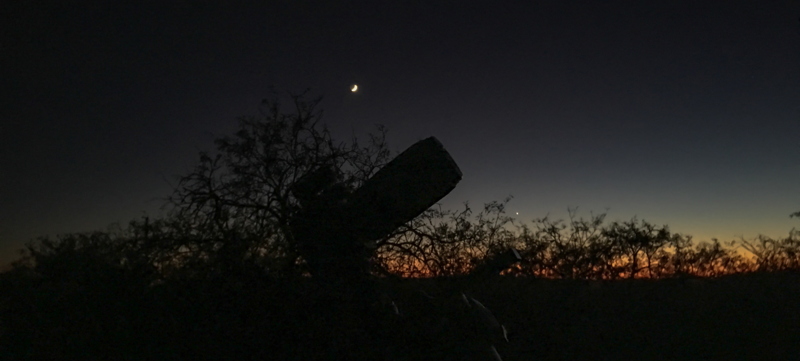iPhone Moon Imaging,
DSLR Sky and DSO Astrophotography
Posted: 5 September 2016
|
Open: Sunday, 4 September 2016, 1805 MST Temperature: 101°F |
Session: 1008 Conditions: Clear, breezy |
Equipment Used:
12" f/8 LX600 w/StarLock
Wireless AutoStar II handset
2" 24mm UWA eyepiece
2" 9mm 100° eyepiece
LXD55 GEM
Camera:
iPhone 6s Plus
D7200 DSLR
I set up my old Meade LXD55 GEM to do sky astrophotography with the D7200 DSLR:

Switched to the Wireless AutoStar II for the LX600. 1828 MST: LX600 ON, ST/HP OFF. 1833 MST: viewed the crescent Moon, 102X. The craters Petavius and Langrenus looked nice. 1846 MST: sunset. Calm now. The planet Venus was easily visible to the naked eye.
1900 MST: handheld iPhone 6s Plus photo of the Moon, afocal 102X:

Mounted the iPhone on the 12" LX600 using the Orion SteadyPix for this afocal 281X photo showing Petavius and Langrenus:

The Apple Watch was used as a remote shutter release for the above photo. Here is how the Moon appeared live on the Watch:

1912 MST: the planet Jupiter was faintly visible to the naked eye very low in the western sky. I did some lunar observing, 271X.
1925 MST: this iPhone photo shows the crescent Moon, Venus (just above the trees), and the DSLR with telephoto lens:

1930 MST: the Moon was now too low in the sky for good viewing. Slewed to Mars and viewed it at 271X. Seeing was not great but Syrtis Major and a limb cloud were visible. Saturn was higher in the sky and afforded a better view at 271X. Cassini Division was visible nearly 360° around the Ring. The moons Titan, Rhea, and Dione were visible, 271X. Then finally saw the moon Tethys, 271X; it was close to the planet and difficult to see against the Ring's glare.
1958 MST: viewed M16 (Eagle Nebula), 102X. Some nebulosity was visible against the still bright sky. M8 (Lagoon Nebula), 102X, was a pretty view. M17 (Swan Nebula), 102X, was also a nice view. M20 (Trifid Nebula), 102X; some nebulosity was visible, but the sky was too bright for a good view.
2015 MST: began preparing for D7200 DSLR sky photography with the LXD55 GEM. Did a focus test on the star Polaris using the Gerd Neumann Bahtinov Mask for Camera Lens. LXD55 ON, CALIBRATE MOTOR, Easy Align. Did a GOTO M31 (Andromeda Galaxy). Once it was centered in the camera viewfinder I began imaging it.
M31 (Andromeda Galaxy), and its companion galaxies M110 (above) and M32 (right), f/4.8, 1 minute, ISO 12800, FL 135mm, White Balance 4000K:

Milky Way, with observatory dome, f/3.5, 2 minutes, ISO 3200, fisheye 8mm, WB 4000K:

2116 MST: ended sky astrophotography. Began preparing for 12" LX600 Deep Sky Object (DSO) astrophotography. High Precision ON, mounted DSLR at prime focus + focal reducer. Slewed to M16 (Eagle Nebula) and focused with mask. StarLock ON for autoguiding. At the end of the exposure the StarLock was turned OFF. I repeated this process of focusing on High Precision centering star and then using the StarLock for guiding for all these photos.
M16 (Eagle Nebula), 1 minute, ISO 6400, WB 4000K

M17 (Swan Nebula), 1 minute, ISO 6400, WB 4000K

M20 (Trifid Nebula), 1 minute, ISO 6400, WB 4000K

M8 (Lagoon Nebula), 1 minute, ISO 6400, WB 4000K

How many galaxies can you see in this photo of the Hercules Galaxy Cluster, 3 minutes, ISO 6400, WB 4000K:

NGC7331 (galaxy) and several companion galaxies, 3 minutes, ISO 6400, WB 4000K:

M33 (Triangulum Galaxy), 2 minutes, ISO 6400, WB 4000K:

2248 MST: ended DSO imaging. Unmounted the DSLR. I think I'm close to getting good StarLock autoguiding. Still need to try longer exposures.
StarLock and High Precision OFF. Viewed the planet Neptune, 102X. Small blue disk visible. The view was better at 271X. Then viewed the planet Uranus, 271X. Seeing was not good, but the disk was nicely visible.
2310 MST: viewed M31 (Andromeda Galaxy), 102X. Gorgeous view with lots of structure visible! M32 and M110 galaxies were nice as well. 2315 MST: watched a slow moving satellite (Earth orbiting) pass along the length of M31. Neat.
2328 MST: began closing up.
|
Close: Sunday, 4 September 2016, 2344 MST Temperature: 72°F |
Session Length: 5h 39m Conditions: Clear, breezy |
I have posted a review of the Lunt Solar Systems SUNoculars 8x32.
Comments are welcome using Email. Twitter users can use the button below to tweet this report to your followers. Thanks.
Cassiopeia Observatory Home Page
Copyright ©2016 Michael L. Weasner / mweasner@me.com
URL = http://www.weasner.com/co/Reports/2016/09/05/index.html
